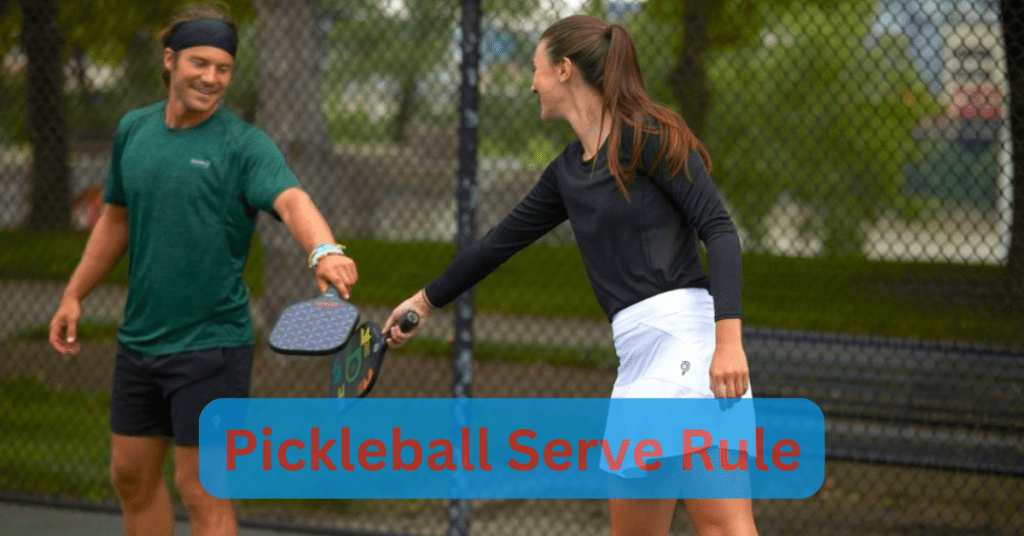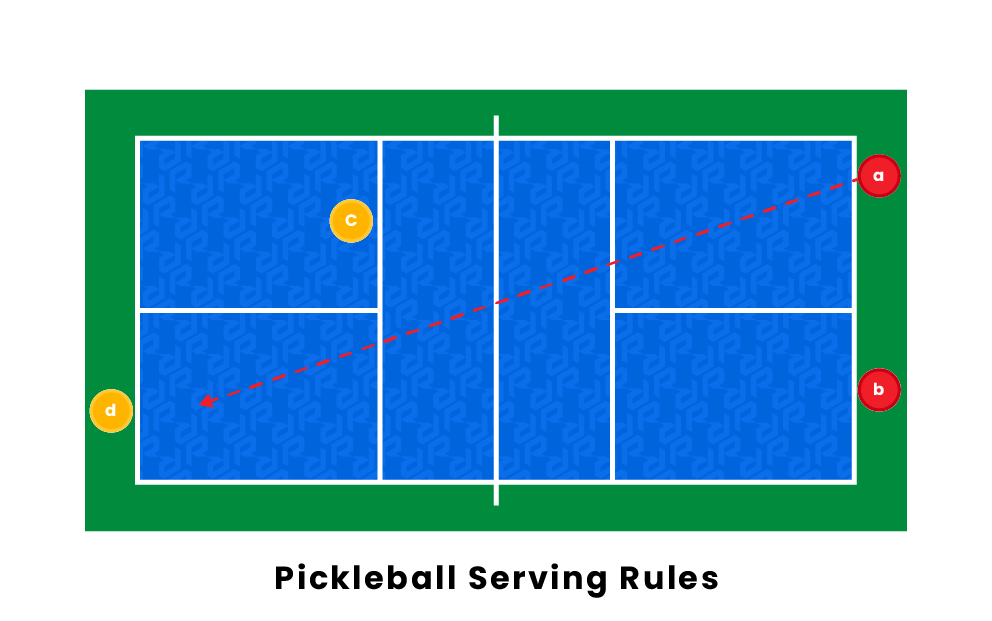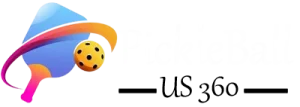
Pickleball is an exciting, fast-paced sport that combines elements of tennis, badminton, and table tennis. Paddles and plastic balls with holes are used in the game, which is played on a court. The serve plays an integral role in how each match progresses – understanding pickleball serve rules can help ensure fair play for everyone involved.
What exactly is a “pickleball serve”? In this article, we’ll explore the rules of serving in detail, including who serves first, where they should stand when serving, how many times they can hit the ball before it goes out-of-bounds or touches their paddle more than once during one stroke – plus much more. Finally, we’ll look at some common mistakes players make regarding their serves so that you don’t fall into similar traps yourself while playing competitively or recreationally.
So let’s dive in and take a closer look at what makes for an effective pickleball serve.
What is a Pickleball Serve?
Chapters
Toggle
The pickleball serve is a key part of the game, and you should know how to do it. The first step is to understand what a pickleball serve is.
A pickleball serve is when you throw the ball against your opponent’s side of the court. This can be done by hitting either one or two walls of the court with your paddle before hitting the ball.
The goal of this maneuver is to send the ball toward your opponent in such a way that they cannot return it with ease. This means that you want to aim for an area where there are no walls or if there are walls, they are very close together and will not allow for much movement on your opponent’s part.
As pickleball continues to grow in popularity, it’s important for players of all levels to understand the basic rules and regulations surrounding serving. Serving is a fundamental part of the game, so mastering this technique can help you become a better player overall.
Basic Pickleball Serve Rules
Pickleball is an exciting sport that combines elements of tennis, badminton, and table tennis. It’s a great way to stay active while having fun with friends or family. One of the most important aspects of pickleball is mastering the serve. Knowing how to properly serve will give you an edge on the court and help you score points more easily. Here are some pickleball serving rules:
The server must stand behind both sidelines when they begin their service motion – this ensures that they don’t cross over into their opponent’s side before striking the ball.
The server must hit diagonally across from them – this means if they’re standing on one sideline, then they should aim their shot at a point across from them on the other sideline (and vice versa).
The ball has to travel over the net without touching it first – if it touches any part of netting before going out-of-bounds or being returned by your opponent then it’s considered faulted and your opponent gets a point automatically.
If there are two players per team then each player can only serve once during each game rotation (this doesn’t apply for singles matches where only one person serves).
After serving five times in succession, players must switch off who serves next so that no single player dominates all five services consecutively (again not applicable for singles matches since there’s just one person serving).
When returning service shots back towards your opponent’s side make sure not to go too close as hitting someone with either racket or ball results in automatic loss/point given away. This rule applies even if accidental contact was made unintentionally – safety always comes first when playing sports like Pickleball.
Following these simple pickleball service rules will ensure smooth gameplay and an enjoyable experience while learning how to play Pickleball correctly.
Whether you’re new to Pickling or have been playing for years understanding proper technique can help improve performance overall as well as increase chances of winning games against stronger competition down road ahead,
Legal vs. Illegal Serves
As pickleball players, it’s important to understand the differences between legal and illegal serves. Knowing what is allowed and what isn’t can help you gain an edge over your opponent while playing the game.
The first difference to note is that a player must use an overhand stroke when serving in pickleball, meaning no underhanded or sidearm strokes are permitted.
Additionally, all services must be made above the waist for them to be considered legal. Any serve below this line would result in a fault being called on the server.
When serving with their paddle head, players should ensure that it stays above their wrist at all times during contact with the ball – if not then they will have committed another fault as well as having served illegally.
This rule applies regardless of whether they are using one hand or two hands for gripping their paddle before making contact with each shot too. So always make sure your grip remains comfortable yet secure throughout every point played.
Finally, there is no set time limit between each serve attempt, aside from general court etiquette. Most tournaments enforce a 10-second rule. This rule states that servers cannot take more than 10 seconds after receiving service. They must attempt their own return shot back into play. If not, they could face penalties. These penalties may include a loss of points. The penalties depend on the tournament format and location. Keep this in mind when competing in any given moment.
In summary, always remember these points when playing pickleball. Only overhand strokes are valid. They must be delivered above waist height. Use grips that keep paddle heads held up by wrists, at least. And don’t forget about the pesky 10-second rules.
Pickleball Drop Serve Rules and Volley Serve
In pickleball, a drop serve is a serve that causes the ball to fall into the opposite court, or land on the opposite side of an imaginary line that bisects the court. It can be performed either in-hand or by using an overhead swing.
If you’re serving from the left court (left side of the net), then to perform a drop serve, you’ll need to release your grip on the paddle and let go at least one inch above the top edge of your right shoulder. If you’re serving from the right court (right side of the net), then you’ll need to release your grip on the paddle at least one inch above your left shoulder.
If you’re playing doubles, then both players have to perform a drop serve at least once during each game—that means both players must do it in order for it to count toward their total number of drop serves per game.
While a volley serve is executed by hitting the ball out of the air without letting it bounce. This type of serve is not allowed in official pickleball games.
The volley serve is the most difficult skill to master in the sport. It is not allowed in official pickleball games, but many players still try to perfect it anyway.
In order to get a good volley, you need to make sure that you have enough power behind your shot and aim for a spot that is deep in your opponent’s court. If you are just starting out with this type of serve, it may be difficult for you to get it right on the first try. You’ll need some practice before being able to consistently hit this type of shot accurately.
Pickleball Singles Serving Rules
In singles matches, the server begins from the right-hand side of court and must serve into their opponent’s diagonal service box. After scoring a point, they switch sides and continue serving until losing one point – at which time their opponent becomes server.
Pickleball Doubles Service Rules
For doubles games, both partners stand in adjacent service boxes with one partner starting as server from the right-hand side of court. The same rule applies regarding where to serve: it must land in your opponents’ diagonal box.
When either partner loses a point during play however; both players switch sides so that each has served once before switching back over again after another score is made by either team (this continues until both partners have lost points).
Pickleball Serve Rule Changes in 2023
As you know, the rules for serving in pickleball are constantly changing and evolving. That’s why it’s important to stay up-to-date on the latest official pickleball serving rules 2023. To help you out, we’ve compiled this comprehensive list of all the new changes that have been made to pickleball serve rules 2023 so far:
- The pickleball spin serve rule change has been implemented; now a player can use either an underhand or overhand service motion when spinning their ball during a serve. This means that experienced players can now add more variety to their serves and challenge opponents with different spins each time they step up to the court.
- Another pickleball let serve rule change is regarding let serves. If your opponent does not return your first two consecutive serves correctly, then they will be considered “let served” and cannot make any further attempts at returning them until after another point has been scored by either team (this applies even if one of those initial two returns was correct).
- The pickleball net serve rule remains largely unchanged from last year – except that if both teams agree before starting play, then a legal net service may be allowed as long as it passes completely over without touching any part of its trajectory within 6 inches above or below the top edge of netting material (the same goes for pickleball service rules 2022 too.).
- Pickleball net serve rule 2022, with the removal of the let serve rule, the net serve rule has been updated. A serve that hits the net and lands in the correct service box is now considered a legal serve and play continues.
- A new addition is also being added this year – there will now be mandatory rotation between servers every 5 points instead 4 points like previously required by USAPA regulations; thus ensuring fair gameplay where everyone gets an equal opportunity at winning each game regardless of who starts off with first server duties. Additionally, all other traditional pickup balling service regulations still apply such as no double bounces before contact etc…
- Finally, we come onto perhaps one of the most interesting additions yet – namely pickleball Spin Serve Rules 2023 which allow players greater control over how many spins they put into their shots when performing certain types of services (e..g backspin/ topspin etc…) These specific guidelines were designed specifically keep competitive matches balanced while giving skilled competitors chance showcase some creative flair during high-level games against similarly talented opponents alike..
Tips and Strategies for Serving in Pickleball
Now that we’ve discussed the basics, here are some tips and strategies to improve your pickleball serve:
- Pickleball Bounce Serve Rules: The bounce serve can be an effective way to throw off your opponent’s timing and surprise him with unexpected angles.
- Pickleball Serve Toss Rules: To improve your serve, practice tossing the ball in a consistent manner. Keep your toss pattern simple at first and then make adjustments based on how consistently you can hit the ball with control.
- Pickleball Serving Side Rules: Be aware of the distance between you and your opponents as well as their positioning. Use this knowledge to attack the holes in their coverage by playing shots into open spaces.
- Pickleball Volley Serve Rules: You may only bounce the ball once before delivering it to your opponent’s court when serving in pickleball. However, practicing volleys can help improve your hand-eye coordination and reaction time—skills that can benefit all aspects of your game.
- Five Serving Rules in Pickleball: Remember the five essential serving rules: serve underhand, hit the ball below the waist, stand behind the baseline, serve diagonally, and ensure the ball clears the non-volley zone.
By following these pickleball serve rules, tips and strategies, you’ll improve your own skills as an athlete and become a more competitive player. Keep up with the latest rule changes to ensure that you’re always doing things by the book.
Common Serving Mistakes and How to Avoid Them
Here are some tips for avoiding common serving mistakes in pickleball:
- Don’t serve too hard; you don’t want to push your opponent off the court or force them to move far from where they are standing on the court because they couldn’t reach it. Instead, you want them to have time to return your serve and win the point.
- Don’t serve too soft—you want your opponent to be able to reach your serves so they can return them back over the net.
- Don’t stand too close or too far away from the service line—one foot on either side of it is perfect.
Conclusion
If you want to be a great pickleball player, you have to master the serve. That’s because the serve is the first step in getting your opponent out. It sets the tone for the rest of the game, so it’s important that you use it effectively.
The good news is that with a little practice and knowledge, you can become an expert at serving. This guide will walk you through every aspect of serving pickleball, from how to spot legal vs. illegal serves to how to improve your own game by using different strategies for different situations.
So what are you waiting for? Get out there and start serving up some winning shots.
Frequent ask questions - FAQs
When it comes to doubles play, players serve in a specific rotation – with the first server starting from the right-hand court and serving diagonally. After a fault by either player on their team, it will be up to the second server to serve from the left-hand
court. If both servers fault then the opposing team gets their turn at service.
As of now, there are no significant changes expected but always best practice to stay updated with the latest rulebooks or tournament guidelines just in case.
All players must ensure that they stand behind baseline within extension sidelines before striking the ball otherwise it’s considered a fault (even if you don’t touch the line)
Yes, the server must follow a few specific rules when serving. For example, his or her feet must be behind the baseline and within the extension of the sidelines while they are in contact with this part of the court. The feet may not touch any lines on either side until after he or she hits them with the ball.
The chainsaw serve, which involves spinning the ball before serving, is currently allowed. However, there have been discussions about potentially changing this rule in the future. Keep an eye on the official rulebooks for updates.
Sharing is caring!
